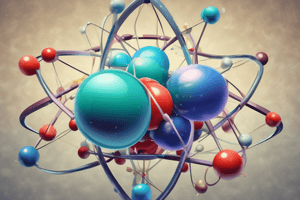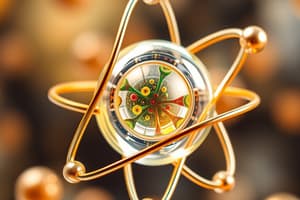Podcast
Questions and Answers
What is the smallest unit of matter?
What is the smallest unit of matter?
atom
What is the center of the atom that contains neutrons and protons?
What is the center of the atom that contains neutrons and protons?
nucleus
What is the outer portion of an atom that contains electrons?
What is the outer portion of an atom that contains electrons?
electron cloud
What are neutrally charged subatomic particles located in the nucleus called?
What are neutrally charged subatomic particles located in the nucleus called?
What are the positively charged subatomic particles located in the nucleus called?
What are the positively charged subatomic particles located in the nucleus called?
What is the average mass of all atoms of an element called?
What is the average mass of all atoms of an element called?
What is the rounded mass of an atom that includes protons and neutrons?
What is the rounded mass of an atom that includes protons and neutrons?
What does the atomic number represent?
What does the atomic number represent?
What is the form of the Isotope symbol?
What is the form of the Isotope symbol?
What is text that is reduced in size and lowered to the bottom of the current line?
What is text that is reduced in size and lowered to the bottom of the current line?
What is text that is reduced in size and raised to the top of the current line?
What is text that is reduced in size and raised to the top of the current line?
What do you call the distance of electrons in the electron cloud from the nucleus?
What do you call the distance of electrons in the electron cloud from the nucleus?
What are the chemical formula(s) on the left side of the chemical equation called?
What are the chemical formula(s) on the left side of the chemical equation called?
What are the chemical formula(s) on the right side of the chemical equation called?
What are the chemical formula(s) on the right side of the chemical equation called?
What is the law that states mass cannot be created or destroyed?
What is the law that states mass cannot be created or destroyed?
What is the number at the beginning of a chemical formula that tells you the number of molecules?
What is the number at the beginning of a chemical formula that tells you the number of molecules?
What are some examples of chemical properties?
What are some examples of chemical properties?
What are examples of physical properties?
What are examples of physical properties?
What is a beam of electrons emitted by the cathode of an electrical discharge tube called?
What is a beam of electrons emitted by the cathode of an electrical discharge tube called?
What does Dalton's Atomic Theory state?
What does Dalton's Atomic Theory state?
What are atoms of the same element that have different numbers of neutrons called?
What are atoms of the same element that have different numbers of neutrons called?
What is an arrangement of elements in columns based on repeating properties called?
What is an arrangement of elements in columns based on repeating properties called?
Who believed that atoms were indivisible and indestructible?
Who believed that atoms were indivisible and indestructible?
Who transformed Democritus' ideas about atoms into a scientific theory?
Who transformed Democritus' ideas about atoms into a scientific theory?
How can scientists observe individual atoms?
How can scientists observe individual atoms?
What are the three types of subatomic particles?
What are the three types of subatomic particles?
Which subatomic particles are found in the nucleus of an atom?
Which subatomic particles are found in the nucleus of an atom?
Which subatomic particles are distributed around the edge of the atom?
Which subatomic particles are distributed around the edge of the atom?
Why are elements different?
Why are elements different?
Why do isotopes have different mass numbers?
Why do isotopes have different mass numbers?
If an element has an atomic number of 42, what are the numbers of protons and electrons in a neutral atom of that element?
If an element has an atomic number of 42, what are the numbers of protons and electrons in a neutral atom of that element?
What does the number 84 in the name krypton-84 represent?
What does the number 84 in the name krypton-84 represent?
How many protons, electrons, and neutrons does an atom with atomic number 45 and mass number 92 contain?
How many protons, electrons, and neutrons does an atom with atomic number 45 and mass number 92 contain?
Flashcards are hidden until you start studying
Study Notes
Atomic Structure Overview
- An atom is the smallest unit of matter.
- The nucleus is at the atom's center, housing neutrons and protons, where most of an atom's mass is found.
- The electron cloud surrounds the nucleus and contains electrons, representing most of the atom's volume.
Subatomic Particles
- Neutrons: Neutrally charged, located in the nucleus, with a mass of 1 amu.
- Protons: Positively charged, located in the nucleus, with a mass of 1 amu.
- Electrons: Negatively charged particles that exist in the electron cloud.
Atomic Mass and Structure
- Atomic mass is the average mass of an element's atom.
- Mass number is the sum of protons and neutrons in an atom.
- Atomic number identifies the element based on the number of protons.
Isotopes and Symbols
- Isotopes have the same number of protons but different numbers of neutrons.
- Isotope Symbol consists of mass on top, atomic number on the bottom, and element symbol.
Chemical and Physical Properties
- Chemical properties include reactivity, flammability, and the ability to rust.
- Physical properties include shape, size, texture, and state of matter.
Chemical Equations
- Reactants are the formulas on the left side of a chemical equation.
- Products are the formulas on the right side of a chemical equation.
- The law of conservation of mass states mass cannot be created or destroyed; reactants must equal products.
Fundamental Concepts
- Coefficients indicate the number of molecules in a chemical formula.
- Energy levels refer to the distance of electrons from the nucleus, with the first three levels capable of holding 2, 8, and 8 electrons.
Historical Background
- According to Dalton's Atomic Theory, all matter is composed of indivisible atoms.
- Democritus first proposed the idea of indivisible atoms, later scientifically expanded by Dalton.
Practical Applications
- Individual atoms can be observed using scanning tunneling microscopes.
- Understanding atomic structure helps explain why elements differ, primarily due to their unique numbers of protons.
Atomic Composition
- For an element with atomic number 42, it contains 42 protons and electrons in a neutral atom.
- An isotope like krypton-84 has an atomic mass of 84.
- For an atom with atomic number 45 and mass number 92, it has 45 protons, 45 electrons, and 47 neutrons.
Studying That Suits You
Use AI to generate personalized quizzes and flashcards to suit your learning preferences.




